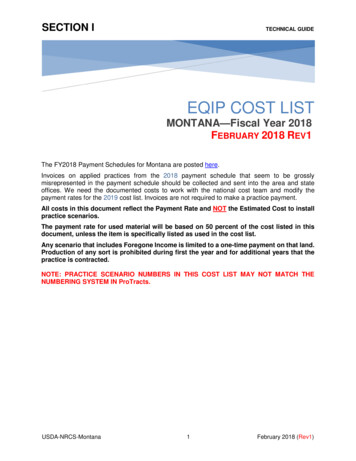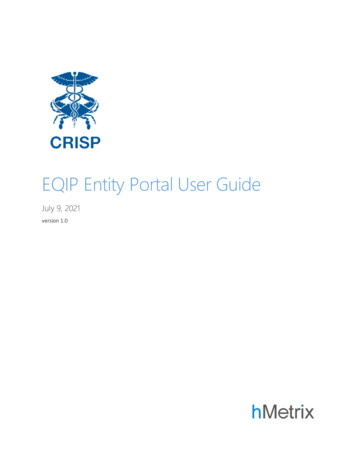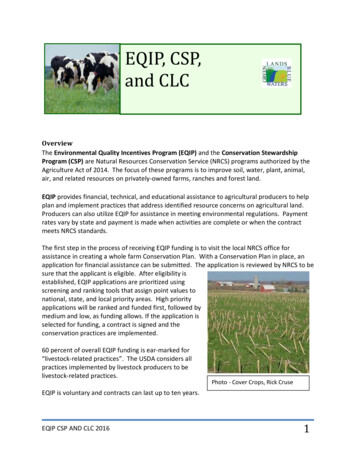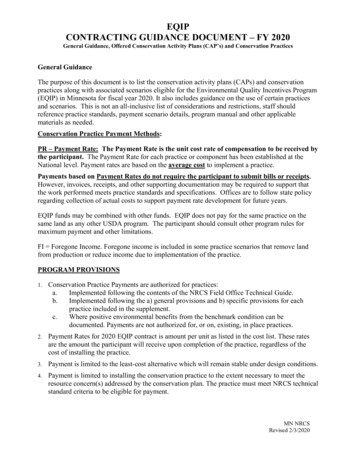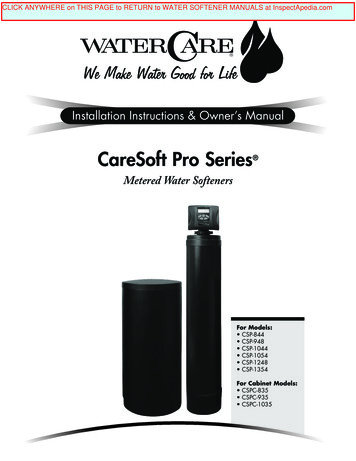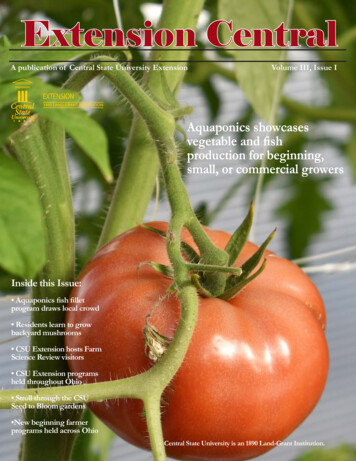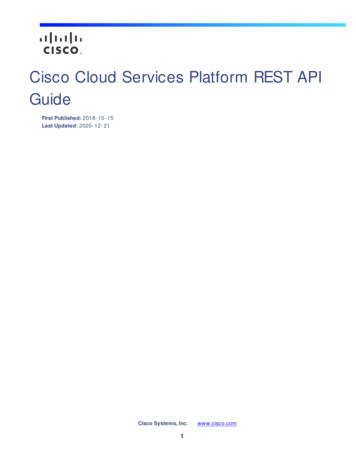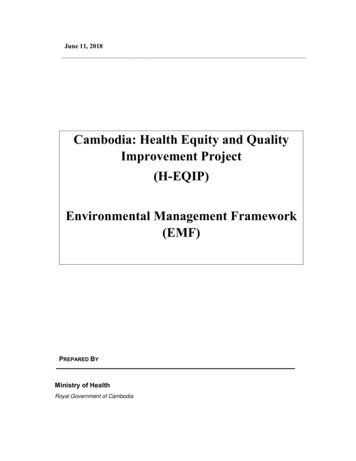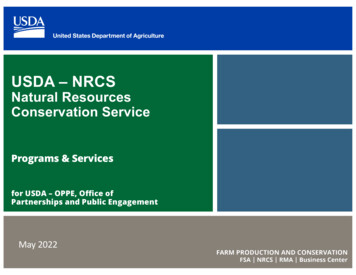
Transcription
USDA – NRCSNatural ResourcesConservation ServicePrograms & Servicesfor USDA – OPPE, Office ofPartnerships and Public EngagementMay 2022
Topics USDA-Natural Resources Conservation Service:Who are we and what do we do? By Jae Lee, Acting ProgramSpecialist, Davis, CA Environmental Quality Incentives Program (EQIP)& Conservation Stewardship Program (CSP)Fundamentals By Jae Lee, Acting Program Specialist, Davis, CA How EQIP and CSP Can Help You! By Alex Hepler, ActingDistrict Conservationist, Fresno, CA Questions and Discussion
USDA-Natural ResourcesConservation ServiceWho are we and what do we do?Jae LeeActing Programs Specialist, NRCS, Davis, CA
We are One of 18 USDA Agencies Agricultural Marketing Service (AMS) FPAC Business Center Agricultural Research Service (ARS) National Agricultural Statistics Service (NASS) Animal and Plant Health InspectionService (APHIS) National Institute of Food and Agricultures(NIFA) Economic Research Service (ERS) Natural Resources Conservation Service(NRCS) Farm Service Agency (FSA) Food and Nutrition Service (FNS) Food Safety and Inspection Service(FSIS) Risk Management Agency (RMA) Rural Development (RD) Rural Utilities Service (RUS) Foreign Agricultural Service (FAS) Rural Housing Service (RHS) Forest Service (FS) Rural Business Cooperative Service (RBS)
NRCSBorn of the Dust BowlConserving Soil, Water, and related Natural Resources Formed in 1935, recognizing "the wastage of soiland moisture resources on farm, grazing, andforest lands is a menace to the national welfare,"Demonstration ProjectsPlant Materials ProgramNational Resource InventoryFlood Control and Watershed PlanningConservation District partnershipsResource Conservation & DevelopmentHonoring 86 Years of NRCS – A Brief History NRCS (usda.gov)Vanguard NRCS programs to improve natural resourceson private lands and production operations Environmental Quality Incentives Programs(EQIP) To 450,000K for 1 to 10 years Conservation Stewardship Program (CSP)Voluntary, non-Regulatory assistance
NRCS Services & Programs Conservation Plans and Technical Assistance Soil Survey Snow Survey and Water Supply Forecast National Resource Inventory Emergency Watershed Protection Watershed and Flood Prevention Operations Easements programs for working farms & ranches, wetlands, and forests
Environmental QualityIncentive Program (EQIP)FundamentalsJae LeeActing Programs Specialist
What is EQIP? The Environmental Quality Incentive Program (EQIP) is our flagshipTechnical & Funding program, for: FarmersRanchersNon-industrial private forestland managersTribal nations Voluntary participation to help improve Soil, Water, and relatedresources Competitive program to help install Conversation Practices, such as,Forest Stand Improvement to reduce fire-threat, Cross-Fencing toimprove livestock forage utilization, and Cover Crops to protect the soiland improve its quality Many, many more Conservation Practices
EQIP FundamentalsEligibility Applicant Land Resource ConcernParticipant must be an agricultural producer orforestland manager or have an interest inproduction and managementEligibility, Applicant: Individuals Entity’s Historically Underserved (HU) participants Beginning Farmer or Rancher (BFR) Socially Disadvantaged (SD) Veteran Farmer Rancher (VFR) Limited Resource Farmer orRancher (LRF) Native Americans Water Management Entities (WME)
EQIP FundamentalsEligibility Applicant Land Resource Concern Eligibility, Land: Private vs. Public Tribal Lands Trust lands Fee Title lands Irrigation History Ineligible Lands, those enrolled in: Conservation Reserve Program (CRP) Wetland Reserve Program (WRP) Conservation Stewardship Program –Grassland Conservation Initiative (CSP-GCI)
EQIP FundamentalsEligibility Applicant Land Resource Concern Example SWAPA HE concerns: Soil – Is there soil erosion? Water – Are there irrigation issues? Air – Can we help reduce emissions? Plants – Are there ladder fuels to control? Animals – Can we help improve habitat? Plus human and energy considerations Over 160 Conservation Practices to help: Vegetative Structural Management
EQIPFundamentals Contracting and Contract Management Contract Reviews Certification and Payment Modifications (minor & major) Termination & Cancellation Contract Expiration Payments and Limitations Advance Payments Contract/Payment Limits Individuals & Entities 450,000 Tribes n/a Joint Operations (GeneralPartnerships and Joint Ventures) 900,000 w/waiver Water Management Entity (WME) 900,000 w/waiver National Organic Initiativeparticipants 140,000 in aggregate,w/no annual limit
EQIPFundamentalsOther Related Programs EQIP-Incentive Contracts (CIC) EQIP-Conservation InnovationGrant (CIG) Regional ConservationPartnership Program (RCPP) EQIP CSP (ConservationStewardship Program) Public Law-566 (PL-566),Watershed Protection andFlood Prevention Act
Conservation StewardshipProgram (CSP)FundamentalsJae LeeActing Programs Specialist
CSP Primer – What is CSP?It’s the Conservation Stewardship Program.From our website:“CSP helps agricultural producers maintain and improve theirexisting conservation systems and adopt additional conservationactivities to address priority resources concerns. Participants earn CSPpayments for conservation performance - the higher the performance,the higher the payment.”From National website:“Our Conservation Stewardship Program (CSP) helps you build onyour existing conservation efforts while strengthening your operation.CSP is for working lands. It is the largest conservation program inthe United States. Thousands of people voluntarily enroll in theprogram because it helps them enhance natural resources andimprove their business operation.”
CSP Primer – Historyof Payments Payments to producers evolved. Farm Bills addressed, for example: Earliest FBs: Over-production as much as Conservation 1985: FB: Required conservation To receive any USDA benefits 2014 FB: Shift away from stabilizing commodities Today: Conservation Payments Authorized for 60 billionof 867 billion 2018 FB CSP biggest acreage-based cons. program
CSP Primer – History of Payments (cont.) Today (continued), nationally: CSP EQIP about 23% of conservation Payments CSP authorized up to 1 billion annually CA-NRCS, FY ‘21 EQIP over 102 million CSP less than 3.5 million High performing CA producers may be missing out onimportant Conservation Payments.
CSP Primer - CSP andEQIP CSP ideal for Tribes and other producers who havedemonstrated higher levels of conservation andmanagement Through EQIP or other documented verifiable efforts CSP strong focus on Management and Vegetativepractices, tiering to existing management adopted, forexample, thru EQIP EQIP Conservation Incentive Contracts (EQIP-CIC) –focus on management; potential transition to CSP CSP People managing the land
CSP Primer – Eligibilityo Applicanto Persons, Tribes, Entities, Joint Operations, forexampleo Land (all Eligible Land must be enrolled)o Agricultural, associated ag land (AAL), farmsteado Non-industrial private forestland (NIPF)o Public land associated with above as workingcomponent of the operation & under effectivecontrol of the applicanto Ineligible Land – refer to 530.302 D(4). Examples:o Newly planted after 12/20/2018o Restrictions to CRP, WRE/WRP, and othereasement & rental programso Other factors (newly acquired, cropping history)o Stewardship threshold – next slide
CSP Primer – Eligibility(cont.) Stewardship threshold eligibility (STE) Assessing level of existingmanagement Based on observable conditions anddocumented activity Meet or exceed threshold At least two (2) ResourceConcern (RC) Categories on allLand Uses at time of enrollment,plus, At least one (1) additional RCcategory by end on at least oneLand Use. Calculated by our Business Tools
CSP Primer – Plan & Activities Conservation Stewardship Plan & Activitieso Conservation Activities§ Practices§ Enhancementso EAP1 Existing Activity Payment for land useo EAP2 Existing Activity Payment for ResourceConcerns met at time of enrollment
CSP Primer – PaymentsTypes of Payments Annual payments (1 and 2 are Existing Activity Payments, EAP)1. EAP1 – Based on Land Use and Acreage2. EAP2 – Based on # of RCs met or exceeded3. New Conservation Activities Minimum payments - 1,500 year;
CSP Primer – Payments EAP1 Land use Cropland 7.50/acre Pastureland 3.00/acre Rangeland 1.00/acre NIPF 0.50/acre EAP2 RCs Met 300/each Enhancements and other Activities 157 Enhancements 27 Bundles AGM, RCCR, IRCCR
CSP Primer – PaymentsOther Payment Info 200,000 Payment limitations 200,000 Contract limitation 900,000 AGI limitTribes do not have these LimitationsLimits DO apply to Individual Tribal members
CSP Primer - Contracts Contracts & Renewalso CSP contracts are for 5-years.o Must apply for Renewal in 5th year
CSP Primer – CSP Grassland Conservation Initiative CSP Grassland Conservation Initiative (CSP-GCI) – NRCS & FSA shareadministration of CSP-GCIo Applicationo FSA notifies producers with potentially eligible lando Only Base-acreage: grass, idle, fallow between 2009 and 2017 at least.Planted or considered planted.o Eligibilityo Producers may enroll 1-time between 2019 and 2023o Must be grassland or permanent vegetative covero 1 PRC to meet or exceedo Must document land use/cover based on field visit or workingknowledge of the farm.o Planningo Existing grassland.o Contracting – 5 years.o Payments – 18/acre not to exceed eligible base acreage
2022 Programs TimelinesBatchingPeriodRanking tionDecember 29,2021January 13,2022January 25,2022February 23,2022December 30,2021January 14,2022January 28,2022March 9, 2022Obligation1Cat Fire22Cat FireEQIP -Cover CropInitiative3All EQIP Ranking PoolsDecember 10,2021December 10,2021January 18,2022December 10,20214All EQIP Ranking PoolsApril 1, 2022May 27, 2022June 15, 2022June 8, 2022September 2,20225EQIP Sage GrouseMay 6, 2022July 8, 2022July 11, 2022August 5, 20226All CSP ClassicEQIP – ConservationIncentive Contract(CIC)April 1, 2022May 27, 2022June 1, 2022August 5, 2022April 1, 2022May 27, 2022June 1, 2022August 5, 20226March 18, 2022March 18, 2022February 11,2022
END
Questions?
What is EQIP? The Environmental Quality Incentive Program (EQIP) is our flagship Technical & Funding program, for: Farmers Ranchers Non-industrial private forestland managers Tribal nations Voluntary participation to help improve Soil, Water, and related resources Competitive program to help install Conversation Practices .
